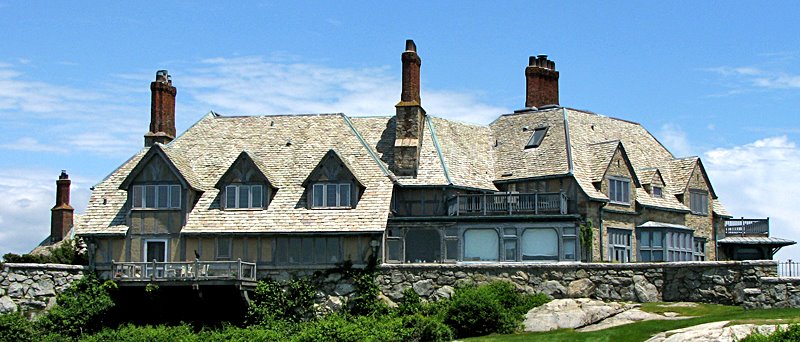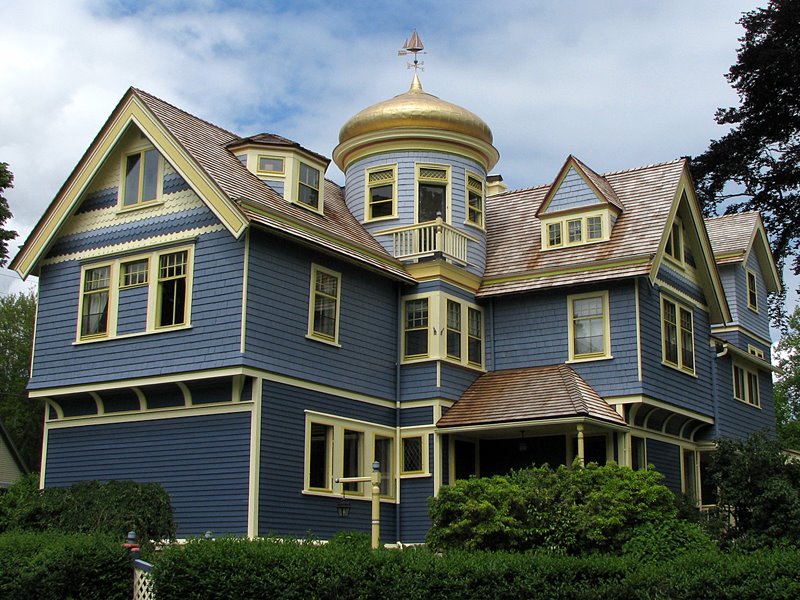

© 2009 by A. Roy Hilbinger
A potpourri of photography and words about Nature, social issues, and anything else that crosses my path during the day.


 Fountain on a private estate on Bellevue Ave., shot at shutter speed 0"5 (1/2 second).
Fountain on a private estate on Bellevue Ave., shot at shutter speed 0"5 (1/2 second).


 Well my goodness! Colette Amelia at The whole ball of wax in a nutshell has bestowed an award on me - the "I Love This Blog" award. I'm flabbergasted, flustered, gobsmacked, speechless... Apparently this award is something like the Oscars of the blogosphere, an award for merit voted by your peers.
Well my goodness! Colette Amelia at The whole ball of wax in a nutshell has bestowed an award on me - the "I Love This Blog" award. I'm flabbergasted, flustered, gobsmacked, speechless... Apparently this award is something like the Oscars of the blogosphere, an award for merit voted by your peers.1) Grab the Award and link love the person from whom you got the award.
2) Pass the award to different bloggers who you think are deserving of this award.
3) Write a post about the award and there you’ll link the person who gave the award to you and those people who you’d like to pass the award.
4) Continue your passion in writing because your hard work will always be appreciated.
Thank goodness this one doesn't make you pass it on to 10 people as some do. It's easier, and more meaningful, to pass it on to a treasured few. Here are mine:







 The history of Biblical manuscripts and textual criticism is full of tales about monks messing with the manuscripts in an attempt to force the text be be more aligned to the church's idea of orthodoxy, and also tales of translators who used their knowledge for the same purpose. The Textus Receptus (Latin: received text) is probably the prime example of this. It was the Greek text of the New Testament that Dutch Catholic philosopher Desiderius Erasmus put together as the foundation to be used for translation to Latin (and later other languages). Most Reformation-era vernacular translations of the Bible relied on it - Martin Luther's German Bible, Tynedale's and King James' English translations, and even the Catholic English translation, Douay-Rheims.
The history of Biblical manuscripts and textual criticism is full of tales about monks messing with the manuscripts in an attempt to force the text be be more aligned to the church's idea of orthodoxy, and also tales of translators who used their knowledge for the same purpose. The Textus Receptus (Latin: received text) is probably the prime example of this. It was the Greek text of the New Testament that Dutch Catholic philosopher Desiderius Erasmus put together as the foundation to be used for translation to Latin (and later other languages). Most Reformation-era vernacular translations of the Bible relied on it - Martin Luther's German Bible, Tynedale's and King James' English translations, and even the Catholic English translation, Douay-Rheims.9) ουτως ουν προσευχεσθε υμεις πατερ ημων ο εν τοις ουρανοις αγιασθητω το ονομα σουMy translation of these verses is:
10) ελθετω η βασιλεια σου γενηθητω το θελημα σου ως εν ουρανω και επι γης
11) τον αρτον ημων τον επιουσιον δος ημιν σημερον
12) και αφες ημιν τα οφειληματα ημων ως και ημεις αφηκαμεν τοις οφειλεταις ημων
13) και μη εισενεγκης ημας εις πειρασμον αλλα ρυσαι ημας απο του πονηρου
9) Instead, you should pray this way: Our father in heaven, your name be revered.Now I need to establish some background. There are some old New Testament texts in Syriac, a variant of Aramaic. The earliest was put together by Tatian in the 2nd Century, called the Diatessaron, which was a book that harmonized the four canonical Gospels, i.e. didn't arrange them as four separate books but arranged them according to similar narrative threads. A later 4th Century text in Syriac eventually developed into the New Testament of the eastern monophysite churches, such as the Assyrian Orthodox and related denominations; it's called the Peshitta (Syriac "simple, common").
10) Bring down your kingdom, fulfill your will, as in heaven so upon earth.
11) Bestow upon us today whatever bread we need.
12) And forgive us our debts just as we ourselves have forgiven our debtors.
13) And do not force us to endure test after test, but rescue us from the evil one.

9) Pray therefore like this: Our father in heaven, hallowed be your name.
10) Your kingdom come, your will be done, as in heaven so on earth.
11) Give us this day the bread we require.
12) And forgive us our offenses as we also have forgiven those who have offended us.
13) And do not bring us into trial, but deliver us from the evil one. [For yours is the kingdom and the power and the glory for ever and ever.]
Our Father in Heaven, hallowed be thy name.
Thy Kingdom come, Thy will be done, as in heaven, so on earth.
Give us bread for our needs from day to day.
And forgive us our offenses, as we have forgiven our offenders.
And do not let us enter into temptation, But deliver us from evil. For thine is the kingdom and the power and the glory for ever and ever.
O, Birther of the Cosmos, focus your light within us -- make it useful
Create your reign of unity now
Your one desire then acts with ours,
As in all light,
So in all forms,
Grant us what we need each day in bread and insight:
Loose the cords of mistakes binding us,
As we release the strands we hold of other's guilt.
Don't let surface things delude us,
But free us from what holds us back.
From you is born all ruling will,
The power and the life to do,
The song that beautifies all,
From age to age it renews.
I affirm this with my whole being.



After reading CC Miranda's article about The Sauce Boss, and after doing more research on the man and posting my own article here last week, I got a hankerin' for some gumbo. But I'd paid rent last week and was broke, so I had to wait until this week to make some. So Tuesday I hiked down to the grocery store to buy the fixings.
I started with a basic gumbo recipe, but I adapted to make use of local delicacies, such as substituting the local Portuguese sausage chouriço for the Cajun sausage andouille. [Note: No, I did not replace shrimp with local lobster; shrimp is still a lot cheaper!] Also, although my grocery store often has okra, this week they didn't, so I substituted green squash, and it was lovely! But other changes I made had more to do with personal taste and, frankly, concessions to cholesterol issues, like substituting vegetable oil and olive oil for butter. So with that explanation out of the way, let's get down to business.
Oh yeah, this produces roughly 10 servings of gumbo.
Ingredients:
3 or 4 tbs. cooking oil (peanut oil preferred)
3 cloves garlic, minced
2 large onions, chopped; 3 large stalks celery, chopped; 1 lb. green squash, chopped; 2 large Bell peppers, chopped
1/4 cup olive oil
1/4 cup all-purpose flour
1 lb. boneless, skinless chicken breast, cubed
8 cups water
1 lb. plum tomatoes, diced (and use all liquid and pulp) OR 1 16 oz. can diced tomatoes, undrained
1/2 cup fresh cilantro, chopped; 1 sprig fresh thyme; 2 bay leaves
1 pinch salt; 1/2 tsp ground cayenne pepper; 1 pinch black pepper
1 lb. chouriço (or Spanish chorizo), cut into 1/2 inch pieces
1 lb. medium shrimp, peeled and deveined
1/4 cup Worcestershire sauce; 1/4 cup lemon juice; hot pepper sauce to taste
filé powder
Directions:
1. In a large skillet (or a wok), heat the vegetable oil and sauté (or stir fry) garlic, onions, celery, squash, and bell peppers until golden brown. Set aside.
2. Mix 1/4 cup olive oil and 1/4 cup flour, and cook in a large stock pot over medium high heat, stirring constantly. This is the roux, and it makes or breaks your gumbo. Cook it until it turns a velvet, chocolaty brown. Stir in the sautéed vegetables and the chicken. Cook, stirring, until the vegetables are tender and the chicken is evenly browned. Stir in water and tomatoes. Add the cilantro, thyme, bay leaves, salt, cayenne, and black pepper. Bring to a boil, reduce heat , and simmer for 2 1/2 hours, stirring occasionally.
3. Add the shrimp and chouriço to the stock pot. Stir in the Worcestershire sauce and lemon juice, and splash in the hot sauce to the desired heat level. Simmer an additional 10 minutes, stirring occasionally. Remove from heat, remove the bay leaves, and sprinkle on filé powder. This is crucial: Do not add the filé powder while the gumbo is still on the heat; it'll turn stringy. Remove from the burner first, let it sit for half a minute, and sprinkle on about a palm-full of the powder, and stir. You can add more until you get the desired thickness. But do add it; it acts as a thickener and it adds its own unique flavor to the gumbo. I've seen gumbo recipes without filé powder and I never understood why they left it out!
4. Serve over rice. Chow down time!
 © 2009 by A. Roy Hilbinger
© 2009 by A. Roy Hilbinger
 Last week a friend on Gather.com published an article about the Sermon on the Mount and asked what certain phrases really meant. As someone who reads Koiné Greek and who has also been involved with Biblical Studies for a good long while, I thought I'd lay out some of the things I've come up with, and also discuss some of the existing scholarship on these.
Last week a friend on Gather.com published an article about the Sermon on the Mount and asked what certain phrases really meant. As someone who reads Koiné Greek and who has also been involved with Biblical Studies for a good long while, I thought I'd lay out some of the things I've come up with, and also discuss some of the existing scholarship on these.
First some decisions had to be made. My friend was dealing specifically with some of the Beatitudes, so I decided to keep it at that rather than tackle the whole Sermon on the Mount. There are also two versions of this sermon, one in Matthew 5 and the other in Luke 6. I chose to go with the Lukan version. Both versions are obviously derived from a common source; they share intent and in places identical wording.
Most contemporary Biblical scholars accept the existence, based on internal textual evidence, of a common "Sayings Gospel", a basic list of the words of Jesus as remembered by those who were around and which were passed down (orally at first) in the early Christian community. Early German scholars called this the "Q" document, from the German word Quelle - source. The authors of Luke and Matthew seem to have shared this document as their primary source.
I'm going with Luke for the Beatitudes rather than Matthew because the author of Luke seems to have stuck closer to the source; the wording is simpler and more terse in Luke while the author of Matthew seems to have done some serious editing, adding to the verses shared with Luke, adding whole new verses, and leaving out other, and in my view very crucial, verses. Luke follows classic Jewish oratorical style - reversal: positive/negative, praise/condemnation, congratulating/warning. The author of Matthew eliminates the reversal pattern by leaving out the negative and ignores the whole original point.
So let's go to the text. First, here's Luke 6:20 - 26 in the original Greek:
20) και αυτος επαρας τους οφθαλμους αυτου εις τους μαθητας αυτου ελεγεν μακαριοι οι πτωχοι οτι υμετερα εστιν η βασιλεια του θεου
21) μακαριοι οι πεινωντες νυν οτι χορτασθησεσθε μακαριοι οι κλαιοντες νυν οτι γελασετε
22) μακαριοι εστε οταν μισησωσιν υμας οι ανθρωποι και οταν αφορισωσιν υμας και ονειδισωσιν και εκβαλωσιν το ονομα υμων ως πονηρον ενεκα του υιου του ανθρωπου
23) χαρητε εν εκεινη τη ημερα και σκιρτησατε ιδου γαρ ο μισθος υμων πολυς εν τω ουρανω κατα τα αυτα γαρ εποιουν τοις προφηταις οι πατερες αυτων
24) πλην ουαι υμιν τοις πλουσιοις οτι απεχετε την παρακλησιν υμων
25) ουαι υμιν οι εμπεπλησμενοι νυν οτι πεινασετε ουαι οι γελωντες νυν οτι πενθησετε και κλαυσετε
26) ουαι οταν καλως υμας ειπωσιν παντες οι ανθρωποι κατα τα αυτα γαρ εποιουν τοις ψευδοπροφηταις οι πατερες αυτων
And then here's my own translation of the Greek:
20) And he raised his eyes to his listeners and preached: Congratulations, you poor, for God's domain belongs to you.
21) Congratulations, you who starve now, for you will be filled. Congratulations, you who weep and wail now, for you will laugh.
22) Congratulations to you when people detest you and exclude you, and rail at you and drive you out and call you evil because of the Son of Man!
23) Rejoice on that day and leap for joy! Behold, your reward in heaven will be abundant. Remember that their ancestors treated the prophets the same.
24) But beware you wealthy, for you've already received your consolation.
25) Beware you who are filled now, for you will famish. Beware you who laugh now, for you will mourn and wail aloud.
26) Beware whenever everyone speaks well of you, for that is how their ancestors regarded the false prophets.
This is much easier to understand than the version in Matthew, because the full pattern of reversal language used in Luke is absent in Matthew. This is the full "the last shall be first and the first, last" treatment laid out loud and clear. You lucky man, you're poor, and that means that God is going to give you everything. But you rich guy, you've already gotten all you're going to get. This is classic Jewish prophetic oratory. It rings like a bell!
It's also a vision of Jesus that many Christians are afraid to deal with. It exalts the poor and powerless and it warns those who are complacent with the status quo that they're heading for a fall. This vision of Jesus condemns the disparity between rich and poor and calls Christians to fix that disparity. If you're the kind of Christian who goes to church every Sunday, tithes, maybe even serves on the church board or the altar guild, and thinks this is all it takes to be a "good Christian", then this vision of Jesus will scare the willies out of you. There's nothing smug or self-satisfied about what he calls his followers to do. He wants to shake things up, turn the world upside down and give it a good tumbling. Stasis, status quo, are the enemies of the spirit; so says this vision of Jesus. A friend of mine who was an Episcopalian priest who considered Daniel Berrigan his role model used to say: "If you're a minister of God and you're not in trouble with the authorities, you're not doing your job."
On the other hand, this vision of Jesus also doesn't sit well with the Christian Right, and you won't notice people like Pat Robertson or James Dobson or any other of their gang preaching this vision of Jesus. Why? Because the very people they condemn, the Jesus of this vision raises up. And what they have become are the very things this Jesus warns to beware of. No, I doubt you'll ever hear James Dobson preach this Jesus. I also think Mr. Dobson would probably be very frightened if this Jesus ever appeared on his doorstep.
That's what I think the whole point of the Beatitudes is - to point out that the world is out of balance and needs to be re-balanced. It gives the poor and oppressed a source of hope, and it warns of disaster for the rich, the powerful, and the complacent. And what more appropriate message for the times we now live in?
© 2009 by A. Roy Hilbinger

















 The SVF Foundation preserves endangered heritage breed livestock and poultry breeds. They operate on the 35 acres of the Swiss Village Farm as well as on 11 acres on the adjacent Hammersmith Farm. Normally visitors aren't allowed onto the grounds of the farms in order to protect the endangered breeds from the danger of disease or invasions of "outside" species that could cause problems. But every year on the first Saturday in June the SVF Foundation opens the Swiss Village Farm, the centerpiece of the properties, to the public.
The SVF Foundation preserves endangered heritage breed livestock and poultry breeds. They operate on the 35 acres of the Swiss Village Farm as well as on 11 acres on the adjacent Hammersmith Farm. Normally visitors aren't allowed onto the grounds of the farms in order to protect the endangered breeds from the danger of disease or invasions of "outside" species that could cause problems. But every year on the first Saturday in June the SVF Foundation opens the Swiss Village Farm, the centerpiece of the properties, to the public."In 1914, James started building 'Surprise Valley Farm'- known as 'Swiss Village' to the locals - to house a prize herd of Guernsey cattle he had inherited from his father. He then hired Grosvenor Atterbury and Stowe Phelps as architects to design a village patterned after those in the Italian region of Switzerland. The loose stone resulting from blasting out the 'valley' was used in the farm buildings."
Yes, you read that right; James had the top of Beacon Hill blasted out to create his little "Surprise Valley". It was named "Swiss Village" first by the locals who worked for the James family; everybody swore it looked like a little Swiss village in the Alps. And it's those buildings we're going to look at in this first part of a three-part series on Saturday's visit.
Just up the road from the welcome sign above and across from the poultry coops (not in today's article because they're modern buildings) is the slaughterhouse with its attached smokehouse. This is such an "English country cottage" look, with rolled eaves in imitation of a thatched roof. The smokehouse is the little round attached building in the background left.
Past the slaughterhouse the road comes the the blasted out "valley" and its buildings. This is the view from in front of the carpentry shop, looking across at the barn complex, service buildings, and the bridge. These roofs are tiles rather than shingled. You can see why the workers called this a "village".
This is another view of the barn complex, this time from the top end of the valley, taken from an area to the right of the above picture.
This is a view of the bridge taken from in front of the barn, and the building next to the bridge is the carpentry shop. The bridge served as an aesthetic closing of the circle created by the blasted-out valley and the buildings circling it. The bridge also served as the focus of a daily evening ritual - marching the cattle in from the fields over the bridge to the barns.
Opposite the bridge on the upside of the valley is the creamery. Milk from the Guernseys owned by the Jameses was turned into butter and cheese here.
Outside the circle on the other side of the bridge and bordering the fields is the piggery. I guess the name is self-explanatory. Even though it has nothing to do with the building, that millstone certainly adds to the bucolic ambiance of the structure.
Back inside the circle of the valley and up a grassy lawn next to the creamery is this wisteria arbor. It was here that Mr. and Mrs. James would watch the parade of the Guernseys over the bridge at sunset and toast the "milk toast", clinking their mugs of fresh milk together. I guess the urban wealthy had some odd ideas about country life!

